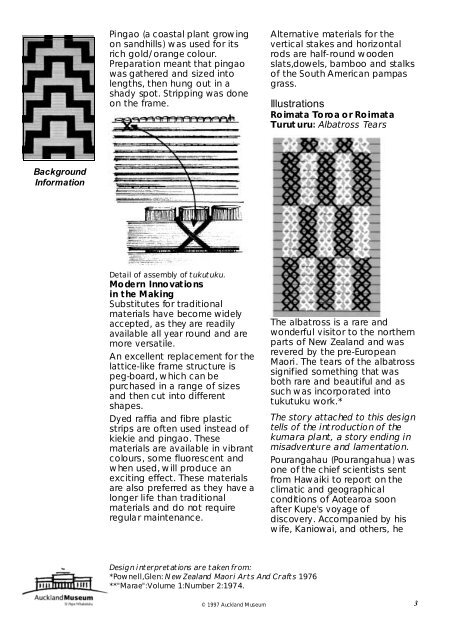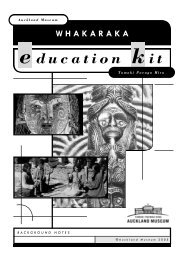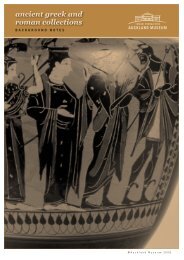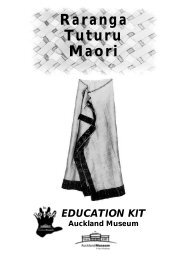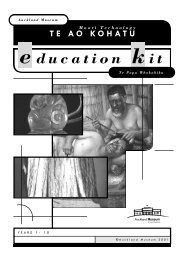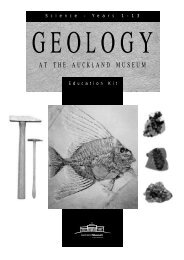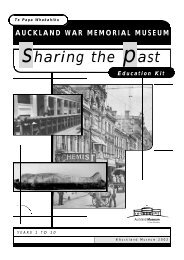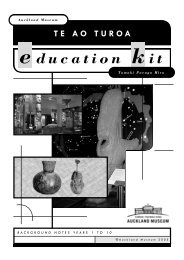Tukutuku Tuturu Maori - Auckland Museum
Tukutuku Tuturu Maori - Auckland Museum
Tukutuku Tuturu Maori - Auckland Museum
You also want an ePaper? Increase the reach of your titles
YUMPU automatically turns print PDFs into web optimized ePapers that Google loves.
Background<br />
Information<br />
Pingao (a coastal plant growing<br />
on sandhills) w as used for its<br />
rich gold/orange colour.<br />
Preparation meant that pingao<br />
was gathered and sized into<br />
lengths, then hung out in a<br />
shady spot. Stripping was done<br />
on the frame.<br />
Detail of assembly of tukutuku.<br />
Mo dern Inno vat io ns<br />
in the Making<br />
Substitutes for traditional<br />
materials have become widely<br />
accepted, as they are readily<br />
available all year round and are<br />
more versatile.<br />
An excellent replacement for the<br />
lattice-like frame structure is<br />
peg-board, which can be<br />
purchased in a range of sizes<br />
and then cut into different<br />
shapes.<br />
Dyed raffia and fibre plastic<br />
strips are often used instead of<br />
kiekie and pingao. These<br />
materials are available in vibrant<br />
colours, some fluorescent and<br />
w hen used, w ill produce an<br />
exciting effect. These materials<br />
are also preferred as they have a<br />
longer life than traditional<br />
materials and do not require<br />
regula r maintenance.<br />
Design interpretations are taken from:<br />
*Pownell,Glen: N ew Zealand <strong>Maori</strong> Arts And Crafts 1976<br />
**"Marae":Volume 1:Number 2:1974.<br />
© 1997 <strong>Auckland</strong> <strong>Museum</strong><br />
Alternative materials for the<br />
vertical stakes and horizontal<br />
rods are half-round w ooden<br />
slats,dowels, bamboo and stalks<br />
of the South American pampas<br />
grass.<br />
Illustrations<br />
Ro imat a To ro a o r Ro imat a<br />
Turut uru: Albatross Tears<br />
The albatross is a rare and<br />
wonderful visitor to the northern<br />
parts of New Zealand and was<br />
revered by the pre-European<br />
<strong>Maori</strong>. The tears of the albatross<br />
signified something that was<br />
both rare and beautiful and as<br />
such w as incorporated into<br />
tukutuku work.*<br />
The story attached to this design<br />
tells of the introduction of the<br />
kumara plant, a story ending in<br />
misadventure and lamentation.<br />
Pourangahau (Pourangahua ) was<br />
one of the chief scientists sent<br />
from Haw aiki to report on the<br />
climatic and geographical<br />
conditions of Aotearoa soon<br />
after Kupe's voyage of<br />
discovery. Accompanied by his<br />
w ife, Kaniowai, and others, he<br />
3


